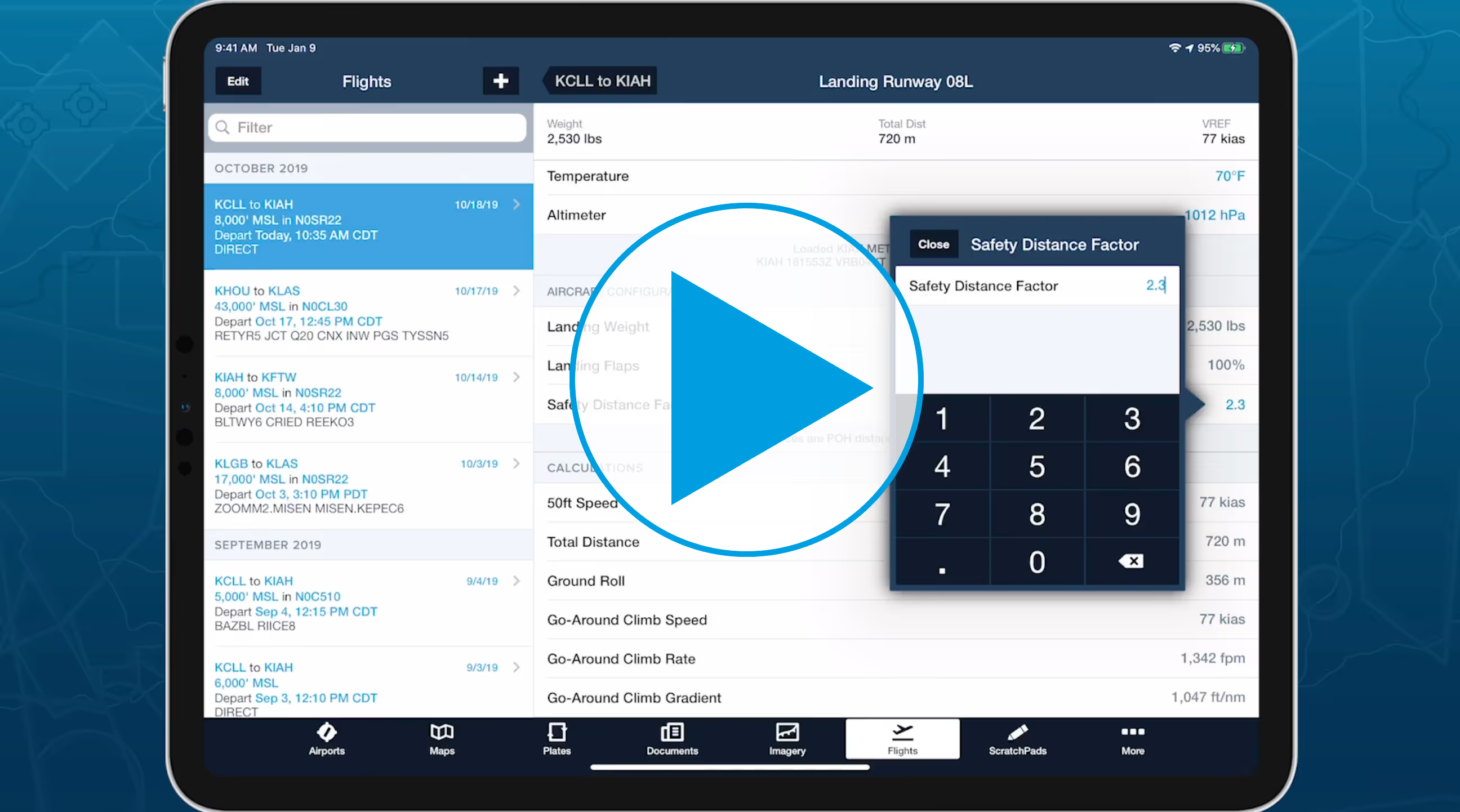Factored Landing Distance Explained: How to Calculate & Key Insights

In aviation, the landing phase is a critical phase of flight. According to the Flight Safety Foundation’s 2022 Safety Report, the majority of corporate jet accidents occur during the landing phase of a flight.
As a data-driven company, we know that runway excursions are the most frequent accident type in aviation for both small and large aircraft. This has been a focal point in many global discussions, leading to the Global Action Plan for the Prevention of Runway Excursions (GAPPRE), a guide with over 100 recommendations for preventing runway excursions.
One of the key tools to prevent runway excursions in the landing phase is factored landing distance - and while it plays a critical role in our runway analysis tool, it’s often a bit misunderstood.
What is factored landing distance?
Factored landing distance is the distance required for an aircraft to land on a given runway. It’s calculated using the manufacturer’s AFM landing performance data and adjusted by an added margin for safety. The margin is mandated by regulation and is determined by multiplying the AFM derived landing distance by a specified factor. Hence the term factored landing distance.
By including factors in your landing distance assessment, you’re providing a safety margin that ensures the aircraft can achieve a successful stop within the landing distance available (LDA). It allows for those days, which is almost every day for most pilots, when the landing technique is not exactly as demonstrated by the manufacturer’s test pilots, and the landing conditions vary slightly from what was expected.
Operators are required to calculate a factored landing distance before takeoff, which must account for aircraft landing weight and forecast conditions on landing. The FAA also strongly recommends pilots perform an additional landing distance assessment in-flight, before landing to account for the actual conditions on arrival. EASA regulations go one step further by requiring an inflight landing distance calculation before every landing.
What factor to use and when to use it is complex. Take a look at the table below from the FAA AC 91-79B, “Aircraft Landing Performance and Runway Excursion Mitigation

The factors in the factor
As you can see, when it comes to factored landing distances, there is no ‘one-size-fits-all’ formula, and simply relying on the Airplane Flight Manual (AFM) on its own won’t suffice.
The AFM provides landing distances based on the shortest possible stopping distance; it doesn’t reflect daily operational practices and conditions. Therefore AFM distances must be adjusted by a landing factor to ensure a safe stopping margin. What adds to the complexity is these factors all vary according to regulations applicable to the specific operator, aircraft type (jet or turboprop), runway surface conditions and available braking systems. Also, some manufacturers may publish data for different runway conditions, and their data may, or may not, already be factored.
FAA regulations say all operators must consider landing conditions at the time of dispatch, but calculating a factored landing distance is mandated for Part 121, Part 135 and Part 91K operators. Other operators may choose to add their own factors as supplementary safety buffers. Indeed, any operator can apply an additional factor to fit their particular operational risk management.
This safety buffer sets a more realistic operator-specific assessment of landing distance required.
How to easily calculate the safety distance factor with ForeFlight

Applying landing factors is detailed, complex, and in most cases, strictly regulated. Fortunately, business aviation dispatchers and pilots can eliminate the risk of human error by leveraging ForeFlight’s Takeoff and Landing Performance feature.
Effortlessly calculate the required landing distance, based on landing factors specific to your operation, in response to real-time runway conditions and all other applicable factors at the time of flight.
Take safe landings to the next level with ForeFlight’s Runway Analysis
ForeFlight’s integrated Runway Analysis and Weight & Balance capabilities enhance operational efficiency and minimize risk by replacing repetitive and error-prone manual data entry with convenient automation based on manufacturer-sourced performance data.
By leveraging ForeFlight’s Runway Analysis functionality, operators can simplify and expedite the flight planning workflow and deliver trustworthy performance results based on manufacturer data.
Here’s how:
Easily calculate landing distances with a range of factors using Runway Analysis
ForeFlight Runway Analysis gives you the flexibility to select the right landing factor for your operation, whether determined by regulatory requirements or your own safety buffer. Select from 5 common landing factors or define your own custom factor for individual flights or per aircraft
Get detailed safety warnings and error messages
With ForeFlight in your arsenal, operators receive various warning and error messages to inform the user when the calculated results exceed the aircraft’s or runway’s limits including aircraft-specific alerts for invalid takeoff or landing configurations or overweight warnings, proactively eliminating the risk of human error.
Effortlessly calculate and confirm landing factors before and during flight
Operators can effortlessly calculate landing performance twice. Once during pre-flight planning using forecasted conditions and again near the top of descent, using actual conditions. Avoid error-prone data reentry while acting on continuous performance calculations to maximize flight safety and prepare for a safe and calculated landing with ForeFlight.
FAQs
What is the difference between unfactored and factored landing distance?
Unfactored landing distance is the landing distance provided by the Aircraft Flight Manual (AFM). It usually represents the maximum performance capability of the aircraft, which is different from normal operational conditions.
Factored landing distance is the AFM landing distance adjusted by the applicable landing factors regulated by the Authority and/or specified by an operator’s procedures.
Factored landing distance is longer than unfactored landing distance. It gives a more realistic landing distance achievable by a typical pilot, for a given aircraft and runway, using forecast conditions at the expected time of arrival. It is mandated by applicable regulations and is an important part of mitigating the risk of runway excursion events.
Variables that affect an aircraft’s landing distance?
Many variables influence landing distance: aircraft weight, the runway surface condition, runway gradient, wind and weather conditions, density altitude, the type of aircraft, its braking systems, and any malfunctions affecting its ability to decelerate.
How do environmental elements, pilot handling and airport facilities affect landing distance?
According to the FAA Advisory Circular
- A 10 knot tailwind significantly adds to the landing distance. Remember reported ‘calm’ or ‘light and variable’ winds may actually be up to 3 knot tailwinds.
- Carrying an extra 10% on approach speed also adds around 20% to landing distance.
In addition:
- Wet and contaminated runways reduce braking efficiency and can significantly increase landing distance.
- Icing speeds for some aircraft types require higher approach speeds and therefore extra landing distance.
- Arriving at an airport with no automated weather observation or runway condition report may leave the pilot without important information for a meaningful landing distance assessment. In this case, a conservative use of landing factors mitigates risk.
- A long flare can add up to a 30% increase into landing distance.
The FAA Advisory Circular also reminds us that the LDA, “can be exceeded when a cumulative effect of the above conditions exists. Pilots need to be aware of this cumulative effect.” So be sure to include all relevant conditions in your factored landing distance calculation.
What do the regulations say about landing distances?
First, be sure to check the regulations that apply to your operation. Here is a brief overview of the regulations by way of illustration:
Pre-dispatch landing distance calculation:
FAA regulations applicable to part 121, part 135 and part 91K operators require calculation of pre-dispatch landing performance, using AFM data. It must determine a landing can be made within 60% of the landing distance available, or 70% for turboprop aircraft.
This is the equivalent of multiplying the AFM landing distance by a factor of 1.67 (or 1.43 for turboprops) and checking this factored landing distance is within the runway’s landing distance available (LDA).
For wet runways, an additional factor of 1.15 must be added. Contaminated runways may need additional factors.
Although not required by regulation, it’s recommended for FAA part 91 operators and pilots to calculate pre-departure landing distance performance requirements based on the guidance contained in their AFM.
In-flight landing distance calculation:
Conditions can change between the dispatch landing performance calculation and arrival at the destination. So, even when pre-departure flight planning requirements have been satisfied, the FAA strongly recommends pilots perform a time of arrival (TOA) landing distance assessment prior to landing. This is a requirement under EASA.
Why should I bother using factored landing distances?
Most corporate jet accidents happen on landing, and runway excursions make up over 75% of those accidents. So it’s a major safety focus.
It’s easy to think, "it'll never happen to me,” but have you ever been surprised at being unable to make the intersection you were planning to vacate at? Or needed heavier than expected braking towards the end of a runway?
What if those things were to happen on a short runway? Or when you landed long, flared high, or had an unexpected tailwind?
Factored landing distance calculations build in an important safety buffer to absorb some of the variables present at every landing, thus reducing your risk of a runway excursion event.





